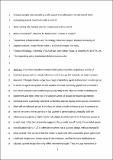Files in this item
Unequal sample sizes according to the square-root allocation rule are useful when comparing several treatments with a control
Item metadata
| dc.contributor.author | Neuhäuser, Markus | |
| dc.contributor.author | Mackowiak, Malwina M. | |
| dc.contributor.author | Ruxton, Graeme D. | |
| dc.date.accessioned | 2022-09-26T23:36:47Z | |
| dc.date.available | 2022-09-26T23:36:47Z | |
| dc.date.issued | 2021-09-27 | |
| dc.identifier | 276055290 | |
| dc.identifier | f01226ab-9b3a-4063-afc5-6ed5b742b24a | |
| dc.identifier | 85115683429 | |
| dc.identifier | 000700011500001 | |
| dc.identifier.citation | Neuhäuser , M , Mackowiak , M M & Ruxton , G D 2021 , ' Unequal sample sizes according to the square-root allocation rule are useful when comparing several treatments with a control ' , Ethology , vol. Early View . https://doi.org/10.1111/eth.13230 | en |
| dc.identifier.issn | 0179-1613 | |
| dc.identifier.other | RIS: urn:91A289E55E982B3CB251E8F81565D6BB | |
| dc.identifier.other | ORCID: /0000-0001-8943-6609/work/100901279 | |
| dc.identifier.uri | https://hdl.handle.net/10023/26073 | |
| dc.description.abstract | A common situation in experimental science involves comparing a number of treatment groups each with a single reference (control group). For example, we might compare diameters of fungal colonies subject to a range of inhibitory agents with those from a control group to which no agent was applied. In this situation, the most commonly applied test is Dunnett's test, which compares each treatment group separately with the reference while controlling the experiment-wise Type I error rate. For analyses where all groups are treated equivalently, statistical power is generally optimised by dividing subjects equally across groups. Researchers often still use balanced groups in the situation where a single reference group is compared with each of the others. In this case, it is in fact optimal to spread subjects unequally: with the reference group getting a higher number of subjects (n0) than each of the k treatment groups (n in each case). It has been previously suggested that a simple rule of thumb, the so-called square-root allocation rule n0 = √kn, offers better power than a balanced design, without necessarily being optimal. Here, we show that this simple-to-apply rule offers substantial power gains (over a balanced design) over a broad range of circumstances and that the more-challenging-to-calculate optimal design often only offers minimal extra gain. Thus, we urge researchers to consider using the square-root allocation rule whenever one control group is compared with a number of treatments in the same experiment. | |
| dc.format.extent | 7 | |
| dc.format.extent | 446785 | |
| dc.language.iso | eng | |
| dc.relation.ispartof | Ethology | en |
| dc.subject | Dunnett's test | en |
| dc.subject | Power | en |
| dc.subject | Sample size | en |
| dc.subject | Square-root allocation rule | en |
| dc.subject | Unbalanced samples | en |
| dc.subject | QA Mathematics | en |
| dc.subject | QH301 Biology | en |
| dc.subject | NDAS | en |
| dc.subject | AC | en |
| dc.subject.lcc | QA | en |
| dc.subject.lcc | QH301 | en |
| dc.title | Unequal sample sizes according to the square-root allocation rule are useful when comparing several treatments with a control | en |
| dc.type | Journal article | en |
| dc.contributor.institution | University of St Andrews. School of Biology | en |
| dc.contributor.institution | University of St Andrews. Centre for Biological Diversity | en |
| dc.identifier.doi | https://doi.org/10.1111/eth.13230 | |
| dc.description.status | Peer reviewed | en |
| dc.date.embargoedUntil | 2022-09-27 |
This item appears in the following Collection(s)
Items in the St Andrews Research Repository are protected by copyright, with all rights reserved, unless otherwise indicated.

